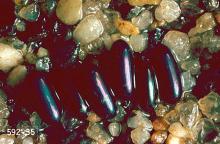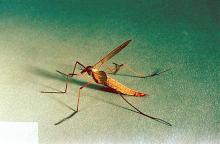European crane fly (Tipula paludosa)
Pest description and crop damage European crane fly (ECF) is a native of western Europe which was introduced to eastern Canada and found in British Columbia in 1965. The mild winters, cool summers and relatively abundant rainfall in the PNW are ideal for this insect and its range now extends as far south as central California. It has been documented east of the Cascades in Spokane, WA and Bend, OR. The adult is a large two-winged fly that is often compared to a large mosquito. ECF has one generation per year. The larvae are wormlike, with leathery skin, 1 to 1.5 inches in length. Larvae hatch in late summer (Aug.-Sept.) and feed through winter and into spring, causing the most damage in the spring (April and May). European cranefly larvae feed on turfgrass shoots, crowns, and roots. Affected turf areas often thin out severely in early spring when normal turf starts vigorous growth. Starlings and other birds are attracted to affected turf and may damage it as they search for larvae.
Biology and life history ECF overwinters as a third-instar larva in the soil. Adult emergence may begin anytime from July to mid-October. Adult males are 14 to 19 mm long, adult females are 19 to 25 mm long. Adult crane flies do not feed-they only drink water-and their life expectancy is 2 to 14 days. They usually mate and lay eggs within 24 hours of emergence. Eggs are laid in turfgrass. Eggs and early instar larvae require a very moist atmosphere or high mortality will occur; therefore, populations are greatest in turfgrass adjacent to saturated soils. Eggs hatch in approximately 11 to 15 days. The young larvae develop rapidly through to the third instar, known as leatherjackets, in which state they overwinter. At this stage the larvae feed on the turfgrass through the winter months into the spring, causing the most damage in the spring months of April and May.
Scouting and thresholds Monitor turf areas starting in November. A common clue that ECF are present is a high level of bird activity on the turf. Scout in the top 2 inches of the soil using a shovel. The action threshold for well-maintained turfgrass is 25 larvae per sq ft.
Management-cultural control
Observations indicate that drought stress at the time of egg laying may significantly reduce larval populations. In the Willamette valley of Oregon, turning off turf irrigation systems shortly after Labor Day will often create enough drought stress to reduce larval populations without causing damage to turf. Unfortunately, around Labor Day is when most of the overseeding and seeding of new lawns is done. If there has been a history of a high population of ECF larvae in the past on your newly seeded site, it would be advisable to apply a preventative application at the time of seeding to limit the feeding of ECF larvae on the newly developing grass plants.
Management-biological control
- beneficial nematodes
Management-chemical control
Products for home use
- bifenthrin- Restricted use
- carbaryl
- chlorantraniliprole
- fenvalerate
- imidacloprid-Some neonicotinoids have been banned from use on public properties.
- indoxacarb
- lambda-cyhalothrin
- plant essential oils-Some formulations are OMRI-listed for organic use.
- pyrethrins-Some formulations are OMRI-listed for organic use.
Products for commercial use
- azadiractin-OMRI-listed for organic use.
- bifenthrin-Restricted use
- bifenthrin + imidacloprid-Restricted use
- bifenthrin + zeta-cypermethrin-Restricted use
- carbaryl
- chlorantraniliprole
- clothianidin-Some neonicotinoids have been banned from use on public properties.
- clothianidin + bifenthrin-Restricted use
- cyantraniliprole
- dinotefuran-Some neonicotinoids have been banned from use on public properties.
- esfenvalerate + prallethrin + piperonyl butoxide-Some neonicotinoids have been banned from use on public properties.
- indoxacarb-Restricted use
- lambda-cyhalothrin
- thiamethoxam-Some neonicotinoids have been banned from use on public properties.




